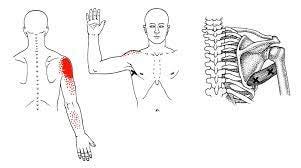Learning more about this the Teres Major:
This is called the Teres Major. Often referred to as “the little helper” because of how it aids the latissimus dorsi in extension and medial rotation of the humerus. But it is not part of the rotator cuff because it does not attach at the shoulders capsule joint. Rather the teres major attaches the humerus to scapula whereas the lats attach to the chest wall.
The problem with the Teres Major
Trigger points in the teres major are often felt deep in the posterior (back) of the shoulder. The posterior deltoid region.
Teres Major Pain Triggered
when reaching up and forward with very little restricted motion. Which is the opposite of it’s function. If you find it hard to steer when driving without causing pain you may have issue with the teres major.
Pain with motion is the chief complaint, but pain can also at occur at rest it is just often described as mild.
Compensation
occurs often in overhead ranges of motion (tennis serve) without the patients being aware of that loss.
Function
of the Teres Major includes adduction, medial rotation, and extension of the arm from ta flexed position primarily working when resisted. It’s strongest activation potential is when adducting across the back. Like reaching for your wallet in your back pocket.
What to do if this is your problem
avoiding situations in which you overload the triggers (forward/upward exercises like dumbbell lat raises) and passive self-stretches to the posterior shoulder are encouraged.
The best solution I have found for this is (if you can tolerate it) hanging from a pull-up bar. You will primarily feel it in the lats and side wall of the thorax but the it will also be addressing the teres major.
Last Point: It’s Uncommon
Only 3% of young healthy adults had tenderness or identifiable weakness in the teres major.
There are no nerve entrapments known to connect with the Teres Major either, but there has been found occasional pain referral to the dorsal (back) of forearm.




